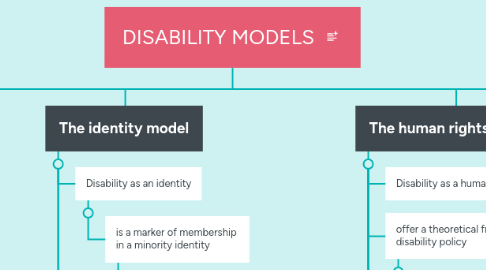
1. medical model
1.1. Disability as a disease
1.1.1. It is a defect in or failure of a bodily system
1.2. From the mid-1800s onwards
1.3. goals of intervention
1.3.1. cure, amelioration of the physical condition and rehabilitation
1.4. Disability is regarded as objectively bad
1.4.1. a personal tragedy for both the individual and her family
1.5. Persons with disabilities
1.5.1. Can avail themselves of the variety of services offered
1.6. Medical professionals
1.6.1. treat people as problems to be solved, without having account the various aspects related to the person’s
2. social model
2.1. Disability as a socially constructed phenomenon
2.2. Inspired by the activism of the British disability movement
2.2.1. in the 1960s and the 1970s
2.3. society
2.3.1. which disables people with impairments
2.3.1.1. solution must be directed at societal change rather than individual adjustment and rehabilitation’
2.4. development
2.4.1. Union of the Physically Impaired against Segregation’s (UPIAS)
2.4.1.1. Disability is a situation, caused by social conditions, which requires for its elimination
2.4.1.2. Impairment
2.4.1.2.1. lacking part of or all of a limb, or having a defective limb, organ or mechanism of the body
2.4.1.3. disability
2.4.1.3.1. the disadvantage or restriction of activity caused by a contemporary social organisation which takes no or little account of people who have physical
2.5. especially concerned with addressing the ‘barriers to participation’ experienced by PWDs
2.6. Impact on social policy at national and international level
3. The human rights model
3.1. Disability as a human rights issue
3.2. offer a theoretical framework for disability policy
3.2.1. emphasises the human dignity of PWDs
3.3. it encompasses human rights, civil, political, economic, social and cultural rights
3.4. respects that some PWDs are indeed confronted by such challenging life situations and argues that such factors
3.5. offers room for minority and cultural identification
3.6. Recognises the fact that properly formulated prevention policy
3.6.1. instance of human rights protection for PWDs
3.7. offers constructive proposals for improving the life situation of PWDs
4. The cultural model
4.1. Disability as culture
4.2. This factors may include medical and social factors
4.3. define disability in different notions of disability and non-disability in the context of a specific culture.
5. The economic model
5.1. Disability as a challenge to productivity
5.2. approaches disability from the viewpoint of economic analysis
5.2.1. focusing in particular on labour and employment capabilities
5.3. insists on the importance
5.3.1. respect, accommodations, and civil rights to people with disabilities
5.4. Utilised by governments as a basic point of reference for formulating disability policy
5.5. contribut to the dehumanisation of the person with disability as someone who is somehow ‘missing parts
6. The identity model
6.1. Disability as an identity
6.1.1. is a marker of membership in a minority identity
6.1.1.1. An acknowledgement of the socially constructed dimension of disability
6.1.1.2. Motivating PWDs to belong to a campaigning group
6.1.1.3. A realisation that there is nothing wrong with PWDs
6.2. This model shares
6.2.1. social model’s understanding that the experience of disability is socially constructed
6.2.2. But it claims disability as a positive identity
6.3. disability is a certain type of experience in the world: social and political experience of the effects of a social system not designed with disabled people in mind
7. The charity model
7.1. Disability as victimhood
7.2. PWDs are victims of circumstance who should be pitied
7.3. sees people with disabilities as victims of their impairment
7.3.1. Their situation is tragic, and they are suffering
7.4. The people should therefore assist PWDs in whatever way possible
7.4.1. they need special services, special institutions, etc., because they are different
7.5. seeks to act to the benefit of PWDs
7.5.1. In the humane treatment of persons with disabilities
7.6. contribut to the preservation of harmful stereotypes and misconceptions about PWDs
8. El modelo moral y / o religioso.
8.1. Disability as an act of God
8.1.1. punishment from God
8.1.1.1. a test of faith or even salvific in nature.
8.2. the oldest model
8.3. is found in a number of religious traditions
8.3.1. blindness, lameness, deafness, uncleanness= chronic illness,
8.3.2. mental illness = demonic possession

